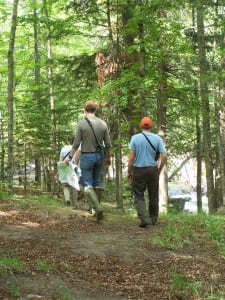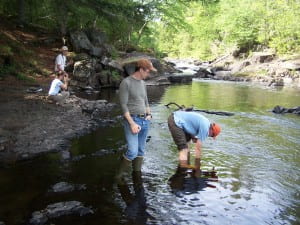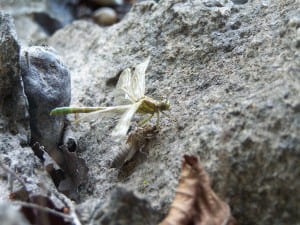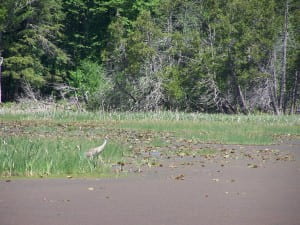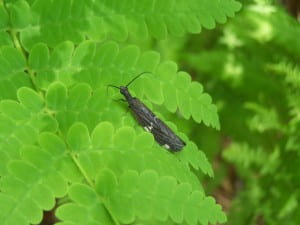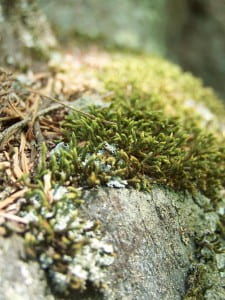One of the many exciting bird research projects that I helped to investigate this summer was with the Nature Conservancy (TNC) in the Wild Rivers Legacy Forest (WRLF) north of Armstrong Creek in northern Wisconsin. With a field crew of eight people, many of us living in one field house, we not only gathered very useful bird survey data for TNC and my graduate thesis project, but we were also fortunate enough to listen to and observe many unique and beautiful bird species. Every afternoon or evening, we met as a group to decide how to break apart all of the required bird survey sites within the forest. Some of us went out in pairs while others surveyed independently to perform as many bird point counts as possible between the half hour prior to dawn until 9:30 AM (the short window of time that breeding birds are allowed to be surveyed). Depending on the terrain, distance between points (via car or on foot), and weather, many pairs or individuals performed as few as 5-6 surveys to as many as 12 in a morning! Therefore, we finished all 200 bird survey sites in the WRLF and the 23 additional sites of poor ecological forest condition in one week’s time!
For some of the bird sighting highlights of this week during the first week of June, we viewed 73 total species within the WRLF including:
16 warblers: American Redstart, Black-and-white, Blackburnian (in large numbers), Black-throated Blue, Black-throated Green (in large numbers), Canada, Common Yellowthroat, Chestnut-sided, Magnolia, Mourning (in large numbers), Myrtle (the official name of the eastern population of the Yellow-rumped Warbler), Nashville, Northern Parula, Northern Waterthrush, Ovenbird (in large numbers), and Tennessee Warblers
Six flycatchers: Eastern Kingbird, Eastern Phoebe, Eastern Wood-Pewee (in large numbers), Great Crested, Least (in large numbers), and Yellow-bellied Flycatchers
Six woodpeckers: in comparison to last year’s data, we observed many more woodpecker individuals: Downy, Hairy, Northern Flicker, Pileated, Red-bellied, and Yellow-bellied Sapsucker (in large numbers) Woodpeckers
Five thrushes: American Robin (in large numbers), Hermit Thrush (in large numbers), Swainson’s, Veery, and Wood Thrushes
Four birds of prey: Broad-winged Hawk, American Kestrel, Barred Owl, and Red-shouldered Hawk
Two vireos: Red-eyed (in large numbers) and Blue-headed Vireos
And several other birds of interest included: Black-billed Cuckoo, Black-capped Chickadee (in large numbers), Blue Jay (in large numbers), Brown Creeper, Common Raven, Chimney Swift, Evening Grosbeak, Indigo Bunting, Purple Finch, Rose-breasted Grosbeak (in large numbers), Red-breasted Nuthatch, Scarlet Tanager (in large numbers), White-breasted Nuthatch, White-throated Sparrow (in large numbers), Winter Wren, and Yellow-billed Cuckoo.
In comparison to the 200 sites of the WRLF, we only observed 47 total species within the sites of poor ecological forest condition, including many of those observed within the WRLF. In these additional sites, however, we also observed the Eastern Bluebird, Eastern Meadowlark, Golden-winged Warbler, Ring-necked Pheasant, and Yellow-throated Vireo, which were not observed during point counts in the WRLF.
For fun in the afternoons, we would gather for lunch at a nearby lake, such as Savage Lake, and enjoy the Black Terns, Sandhill Cranes, and Common Loons, which foraged within a few hundred meters of us. Other days we searched for different bird species (e.g. Bobolink) and other walks of life, such as dozens of dragonfly species, as expertly identified by Ron and Joan. We ran into several deer and quite a few black bears, including one close call during a survey that I was conducting by myself. Around minute three of one ten-minute bird point count survey that I was doing, a large black bear peered through thick brush about 25 meters away from me. After shooing it away from me, it still remained close, only about 200 meters away. Upon completing the bird survey and heading back to my car, it stood on its back legs and kept a close watch over me! Thankfully, it continued to forage and stay clear of me.
In one short week’s time, our dedicated and tireless field crew performed many surveys, which provided this study with incredibly useful data that will contribute towards a vastly important conservation project for the future. Luckily, I had some of the most fun that I have ever had working on a bird field crew and am grateful to be a part of this project. Thank you to all of those expert birders on this crew who helped me to become a better birder!
Please take a look at some of the photographs that I took during this week.
